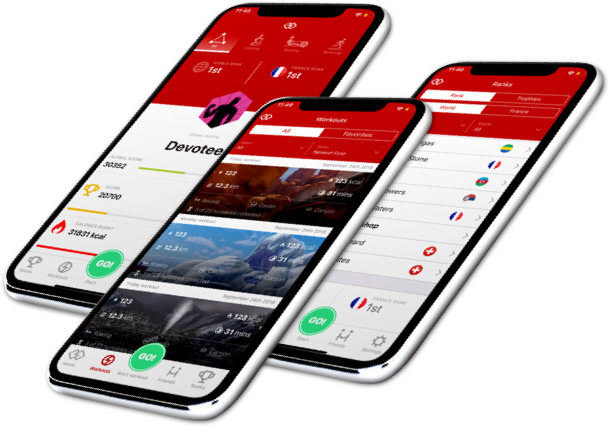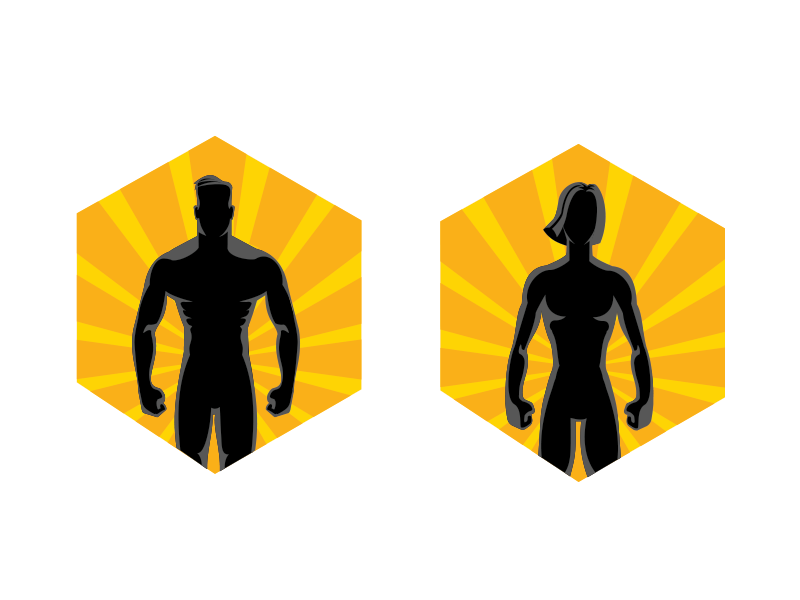
HoloFit | iOS VR Companion App
Companion app for fitness workouts in virtual reality
I had the opportunity to work on an exciting project with Holodia, a company that creates VR fitness apps. The goal of the project was to develop a mobile app that would serve as an extension of their VR app and as a personal companion app for iOS users.
Holodia approached us with a proven concept for a VR fitness app, and we were tasked with creating an MVP (Minimum Viable Product) in order to evaluate it with users. The MVP was tested with a focus group, which were employees at Google's Zurich office.

Design Process
The Holofit app is intended for a wide range of users, including top athletes, regular fitness enthusiasts, and those looking for motivation to improve their fitness and health. The app offers an immersive and engaging experience for users through its virtual worlds and levels. It can be used on any bicycle, elliptical, or rowing machine, and for no-equipment cardio workouts.
One of the key features of the MVP was the ability for users to create a user account, connect with training equipment, track progress, and receive gamification badges. These features were included to encourage user engagement and motivation.
As this was my first time working with VR technology, it presented a challenge for me in understanding how the interface within VR could work and how it would correlate with the mobile app. To ensure that the interface within VR and the mobile app would be cohesive and easy to use, I approached the design process by considering the user's needs and goals, and by constantly testing and iterating the design.

Wireframes
Throughout the design process, detailed wireframes were used to evaluate design decisions with stakeholders. These wireframes provided a clear visual representation of the app's interface and functionality, and were used as a tool for gathering feedback from stakeholders.
By presenting wireframes at various stages of the design process, we were able to gain valuable insights from stakeholders on how to improve the app's user experience. This iterative approach allowed us to make informed design decisions and ultimately resulted in a polished and effective final product.




The final design deliverables for the Holofit app were high-fidelity mockups that were connected to a detailed InVision prototype. The mockups were used to showcase the visual design of the app and provide a realistic representation of how the final product would look and feel.
Additionally, the InVision prototype allowed stakeholders to interact with the app's interface, providing an immersive user experience and allowing for more accurate feedback on the app's usability and functionality. This combination of high-fidelity mockups and an interactive prototype ensured that the final product met the requirements and expectations of stakeholders.




Design Decisions
The key features of the MVP were designed to meet the users needs and goals. The ability for users to create a user account, connect with training equipment, track progress, and receive gamification badges were included to encourage user engagement and motivation.
The design process was approached by considering the user's needs and goals and by constantly testing and iterating the design.
Virtual experience with real results
Results
The final version of the Holofit app includes the key features of the MVP and additional updates and improvements. The app is intended to help users to improve their fitness and health, and offers an immersive and engaging experience through its virtual worlds and levels. The app can be used on any bicycle, elliptical, or rowing machine, and for no-equipment cardio workouts.

Connect Holofit App

To connect the Holofit app with fitness equipment, follow these steps:
1. Open the Holofit app on your phone. Look for a QR code sticker on the fitness equipment, such as a rowing machine or stationary bike. Use the Holofit app to scan the QR code.
2. Place your phone on the side of the fitness equipment, making sure it is securely positioned.
3. Position yourself on the fitness equipment and
4. put on your VR headset.
The app should now be connected to the fitness equipment and you can begin your VR workout.
Level Badges
Gamification

To create a gamified experience for the users of the mobile app, I decided to implement badges that would be earned at each level.
I started by brainstorming a list of potential activities or achievements that users might accomplish while using the app, and then I designed unique badges for each one. For example, I created a badge for completing a certain number of workouts, a badge for tracking nutrition goals, and a badge for participating in community challenges. I also designed special badges for reaching milestone levels or for unlocking certain features within the app.
Overall, the badges added an element of fun and motivation for users as they progressed through the app and worked towards earning new badges.
Conclusion
As the lead designer of the Holofit app, I am proud of the design and development process. The project presented a unique challenge as it was my first time working with VR technology. However, by considering the user's needs and goals, and by constantly testing and iterating the design, I believe that we have created an app that is user-friendly, engaging, and effective.







